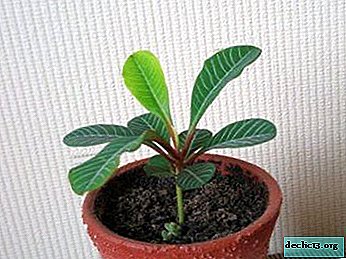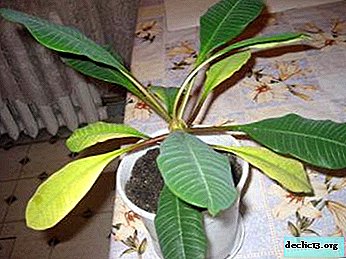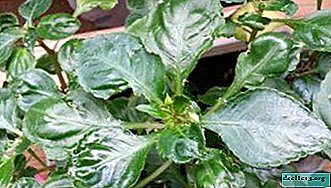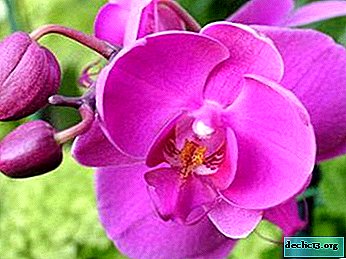Palm tree or Euphorbia whitewashed? Home care and photos

Experienced gardeners have repeatedly heard about a houseplant called euphorbia. Although it has a large species diversity, the most popular is the white-euphorbia euphorbia.
The plant is loved because of its decorative appearance and simple care. It is also believed that the flower brings harmony, prosperity and prosperity to the house. The juice of this plant is poisonous, so it is necessary to grow it in places inaccessible to children and animals.
The article tells how to care for a flower at home: the required temperature, watering rules, light, fertilizers. And also learn about diseases and insect pests that can destroy a flower.
Description of the plant and photo
Euphorbia alba (white-veined) belongs to the family Euphorbia. It is a perennial herb, up to one and a half meters high, with a strong trunk and foliage sultan. On the ribs there are small brown spines everywhere. It resembles a cactus to some because of its thick stem, others associates it with a palm tree, which can be explained by the presence of lush foliage in the upper part of the trunk.
Below is a photo of the plant.





How to take care of a flower?
In order to make competent care for white-milk milk at home, it is necessary to familiarize yourself with the rules and subtleties of the process.
Lighting
The plant is quite photophilous, but constant direct sunlight is poorly tolerated. They can cause burns on the leaves of the flower. The best place for white-milked milkweed will be the windowsill on the north side. It can also be placed in the back of the room. To make the crown look attractive, it is sometimes necessary to turn the flower in different directions to the light source.
Watering
Euphorbia is particularly demanding on moisture in the summer. In summer, you need to water it with plenty of water. With the approach of cold weather watering decreases. The most important thing is to prevent the coma from drying out. A plant likes to be watered with soft, slightly warm water.
Temperature
Do not forget that the homeland of milkweed are warm countries, near the equator. And there, at any time, warm weather prevails. The same conditions should be maintained at home. Any cooling affects the flower badly.
Important! The temperature in the room should not fall below + 15 ... +16 degrees. At lower temperatures, there is a greater likelihood that root rot will develop.Priming
The preparation of the substrate will not be difficult, since the euphorbia is unpretentious and can grow both on soils for succulents and on universal mixtures sold in flower shops.
But you can make the soil yourself, for this you will need: river sand, sheet land and peat, taken in equal amounts. It is recommended to add a pinch of charcoal to the finished mixture.
Pot
An important component is the capacity under the flower. For a superficial rhizome of milkweed, a wide pot or flowerpot is needed. Well, if it is also flat. The pot must have openings on the bottom so that moisture does not linger and air circulates.
Top dressing
 In the role of fertilizer, a store mix for cacti is perfect. To nourish an adult plant begin in March. This month, it is necessary to do doses slightly less than usual, but apply more often, that is, 2-3 times a month.
In the role of fertilizer, a store mix for cacti is perfect. To nourish an adult plant begin in March. This month, it is necessary to do doses slightly less than usual, but apply more often, that is, 2-3 times a month.
From April, they switch to a single monthly payment, which is carried out until September inclusively. Also do not forget that Euphorbia needs periodic nitrogen supplementation. For prevention, it is enough to feed once every 2-3 months.
Pruning
This procedure is done to rejuvenate the flower. How to cut and not harm white-milk milkweed?
To do everything right, you need to know the following:
- Pruning should be done after flowering, that is, in the summer.
- It is necessary to remove dry trunks, side shoots and shorten too long stems.
- In order for the flower to branch, shoots are cut off at the beginning of spring, leaving a bare trunk.
- Wounds are treated with charcoal ash or crushed activated carbon.
- Caring for such milkweed does not change, everything is as usual.
- After a while, new shoots will appear from the old trunk.
Transfer
Transplanting is quite simple, although it slightly injures the flower.
Reference. Young plants are allowed to transplant no more than once a year. But for mature flowers, a three-year interval is recommended.The technology of transplantation is known to all gardeners - first, the soil is prepared, then a bookmark is made in a new container, followed by dusting and gentle care in the first months. During this period, the euphorbia should not be touched without special need, since it gets used to the new environment for him and even transfer to another place can become fatal.
Is it possible to grow in open ground?
Euphorbia is a white-veined photophilous and thermophilic plant. He needs enough sunlight. Originally a flower from the equatorial zone. Given these features, we can conclude that in Russia, euphorbia, it is possible to grow only at home.
Diseases and Pests
Why do leaves turn yellow and fall?
Why turn yellow:
 One reason for yellowing leaves may be a natural process. In the autumn, the plant slows down all vital functions, and it prepares for winter.
One reason for yellowing leaves may be a natural process. In the autumn, the plant slows down all vital functions, and it prepares for winter.- There may be problems with the root system. It is necessary to inspect the milkweed, perhaps it simply does not have enough space in the pot, then the flower is transplanted.
- Lack of nutrients in the soil leads to yellowing of the leaves. Therefore, do not forget about top dressing, especially in the spring.
Why fall off:
- Falling is due to a rotting root system. And it can rot due to excessive moisture. In order for the flower to survive, it is transplanted into a new pot with fresh soil.
- Sudden changes in temperature indicators lead to falling leaves.
- Parasites that settle on it can contribute to subsidence.
Other diseases
On a note. Often, diseases appear due to improper care for milk. For example, a sharp decrease in room temperature or excessive watering can lead to various types of rot.The most common diseases and pests for this species:
- If an olive coating appears on the plant, it means that the flower suffers from gray rot. To cope with the disease, you need to remove the affected processes and sprinkle incisions with wood ash. If this procedure has not yielded results, "Fundazol" is used. You can also use a copper-soap solution (2% soap and 0.2% copper sulfate).
- White plaque - a clear sign of mealybug. To get rid of the plant, it is rubbed with alcohol, and then the top layer of the soil changes and the entire ground mass must be sprayed with "Actara".
- Late blight a dangerous disease that affects the roots and slows down growth. The surviving roots are saved with the help of fungicides, such as: Ordana and Oxychoma.
Useful video
From the video you will learn about the rules for care and transplantation of white-milked milkweed:
Conclusion
Euphorbia is a white-streaked exotic plant native to warm countries. This decorative flower will always please with its beauty and unusualness. Knowing all its features, home care will not be difficult.

 One reason for yellowing leaves may be a natural process. In the autumn, the plant slows down all vital functions, and it prepares for winter.
One reason for yellowing leaves may be a natural process. In the autumn, the plant slows down all vital functions, and it prepares for winter.















